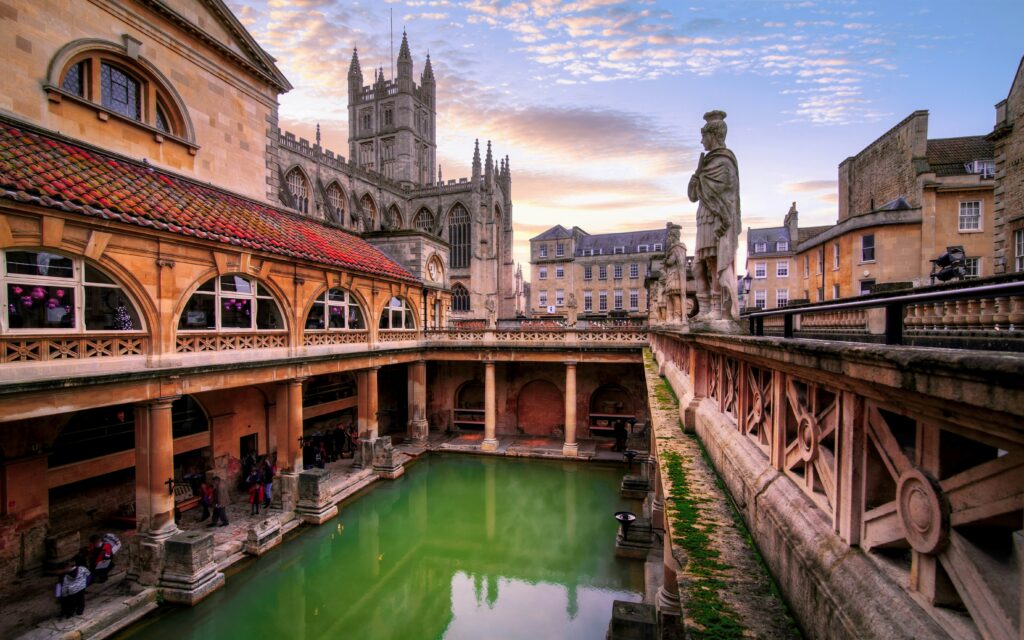Introduction to Bath’s UNESCO Status
Bath is a city unlike any other. In 1987, it was honored as a UNESCO World Heritage City, a title that recognizes its exceptional history, architecture, and culture. This status highlights Bath’s unique charm, combining Roman and Georgian influences with natural beauty. Let’s explore what makes Bath worthy of this global recognition.
The Roman Baths and Their Historical Importance
Bath’s story begins with its Roman roots. The city’s name comes from the Roman Baths, built around 70 AD. These baths were not just for bathing but were places for socializing, relaxing, and worshipping. The Romans believed the hot springs had healing powers and dedicated the site to Sulis Minerva, a goddess of health and wisdom.
Today, the Roman Baths are a major attraction, visited by millions every year. They showcase ancient engineering brilliance and remind us of Bath’s long-standing connection to wellness. These baths were a key reason why Bath became a UNESCO World Heritage City.
Georgian Architecture and Urban Design
Bath’s stunning Georgian architecture defines its character. In the 18th century, architects like John Wood the Elder and his son transformed the city into a fashionable spa town. Landmarks like the Royal Crescent, the Circus, and Pulteney Bridge are perfect examples of this era’s style.
Built with locally sourced Bath stone, these buildings showcase symmetry, elegance, and innovation. The careful planning and timeless beauty of Georgian Bath played a significant role in earning the city its UNESCO World Heritage City status.
Cultural Significance of Bath Through the Ages
Bath is not just about buildings; it’s also a cultural hub. The city has inspired writers, artists, and visitors for centuries. Jane Austen, one of England’s most famous authors, lived in Bath and set parts of her novels “Northanger Abbey” and “Persuasion” here.
Today, Bath celebrates its rich culture with festivals, museums, and events. From literature to music and film, Bath’s cultural vibrancy continues to thrive. This cultural heritage has been key to maintaining its position as a UNESCO World Heritage City.
The Role of Bath’s Natural Hot Springs
Bath’s hot springs make it truly unique. These are the only natural hot springs in the UK, and their mineral-rich waters have been used for thousands of years. The Romans built their famous baths around these springs, believing in their healing properties.
Modern visitors can still enjoy these springs at places like the Thermae Bath Spa. The connection between these natural wonders and Bath’s identity has been a crucial factor in its status as a UNESCO World Heritage City.
Bath’s Journey to UNESCO World Heritage Recognition
Bath’s journey to becoming a UNESCO World Heritage City is a story of preservation and pride. Its Roman roots, Georgian elegance, cultural importance, and natural hot springs combined to make it worthy of this global honor.
Being on the UNESCO list ensures that Bath’s heritage is protected for future generations. It also attracts visitors from around the world who want to experience its beauty and history. From the Roman Baths to the Royal Crescent, every corner of Bath offers something special.
If you plan to visit, consider using a Bath taxi service for a comfortable and convenient way to explore. Whether you need a quick ride or a guided city tour, a reliable Bath taxi can enhance your experience.
Conclusion
Bath’s recognition as a UNESCO World Heritage City celebrates its incredible blend of history, architecture, and culture. From the Roman Baths to its Georgian landmarks, Bath offers a timeless experience that captures the hearts of all who visit. Whether you’re drawn to its historic sites, cultural festivals, or relaxing spas, Bath is a city that truly deserves its place on the world stage.



